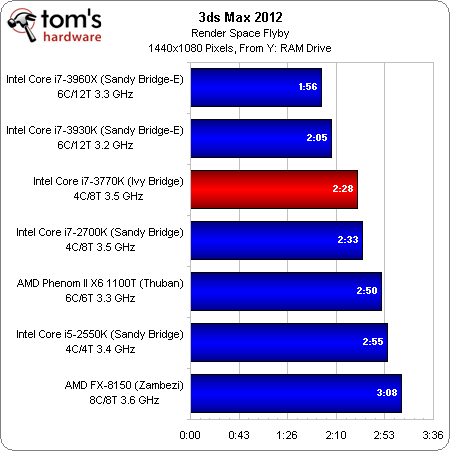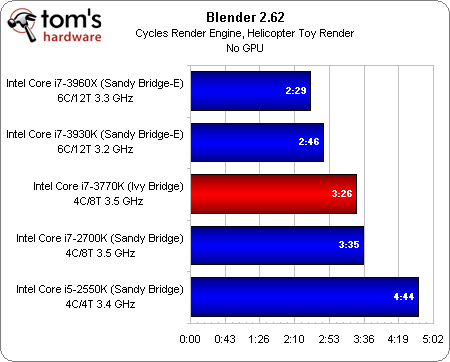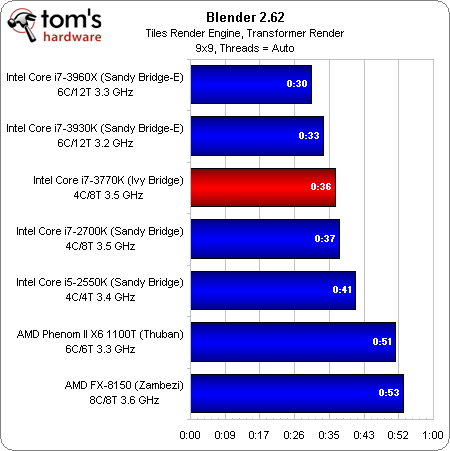Intel Core i7-3770K Review: A Small Step Up For Ivy Bridge
Benchmark Results: Content Creation
Well-optimized for threading, the two six-core Sandy Bridge-E-based chips run away with first and second place in 3ds Max 2012.
Core i7-3770K takes third place, narrowly outperforming the existing Core i7-2700K. The implication here is that Ivy Bridge is only getting a marginal speed-up due to the IPC-oriented improvements that Intel folded in. A difference of five seconds is hardly noteworthy.
The new Cycles engine wouldn’t cooperate with our AMD-based platforms, so we have the results from five different machines with Intel CPUs in them. Both six-core models land in the lead, followed by the Core i7-3770K and -2700K nearly tied for third place. The Core i5-2550K, lacking Hyper-Threading and some shared L3 cache, trails a ways back.
We didn’t have any issues using the older rendering engine on any of our platforms, though the finishing order is exactly the same amongst the Intel-based CPUs. Factoring in AMD’s Phenom II X6 1100T and FX-8150 only tacks those two parts onto the end of the chart.
Same story in SolidWorks. The six-core Intel chips dominate, followed by the Core i7-3770K and -2700K, seemingly joined at the hip. Intel’s Core i5-2550K lands in fifth place, trailed by both AMD processors. Despite the fact that we saw FX-8150 do so stinking well in Photoshop, it simply gets outclassed in all of our content creation titles.
Get Tom's Hardware's best news and in-depth reviews, straight to your inbox.
Current page: Benchmark Results: Content Creation
Prev Page Benchmark Results: Adobe CS 5.5 Next Page Benchmark Results: Productivity-
tecmo34 Nice Review Chris...Reply
Looking forward to the further information coming out this week on Ivy Bridge, as I was initially planning on buying Ivy Bridge, but now I might turn to Sandy Bridge-E -
jaquith Great and long waited review - Thanks Chris!Reply
Temps as expected are high on the IB, but better than early ES which is very good.
Those with their SB or SB-E (K/X) should be feeling good about now ;) -
xtremexx saw this just pop up on google, posted 1 min ago, anyway im probably going to update i have a core i3 2100 so this is pretty good.Reply -
ojas it's heeearrree!!!!! lol i though intel wan't launching it, been scouring the web for an hour for some mention.Reply
Now, time to read the review. :D -
zanny It gets higher temps at lower frequencies? What the hell did Intel break?Reply
I really wish they would introduce a gaming platform between their stupidly overpriced x79esque server platform and the integrated graphics chips they are pushing mainstream. 50% more transistors should be 30% or so more performance or a much smaller chip, but gamers get nothing out of Ivy Bridge. -
JAYDEEJOHN It makes sense Intel is making this its quickest ramp ever, as they see ARM on the horizon in today's changing market.Reply
They're using their process to get to places they'll need to get to in the future -
verbalizer OK after reading most of the review and definitely studying the charts;Reply
I have a few things on my mind.
1.) AMD - C'mon and get it together, you need to do better...2.) imagine if Intel made an i7-2660K or something like the i5-2550K they have now.
3.) SB-E is not for gaming (too highly priced...) compared to i7 or i5 Sandy Bridge
4.) Ivy Bridge runs hot.......
5.) IB average 3.7% faster than i7 SB and only 16% over i5 SB = not worth it
6.) AMD - C'mon and get it together, you need to do better...
(moderator edit..) -
Pezcore27 Good review.Reply
To me it shows 2 main things. 1) that Ivy didn't improve on Sandy Bridge as much as Intel was hoping it would, and 2) just how far behind AMD actually is... -
tmk221 It's a shame that this chip is marginally faster than 2700k. I guess it's all AMD fault. there is simply no pressure on Intel. Otherwise they would already moved to 8, 6, and 4 cores processors. Especially now when they have 4 cores under 77W.Reply
Yea yea I know most apps won't use 8 cores, but that's only because there was no 8 cores processors in past, not the other way around




